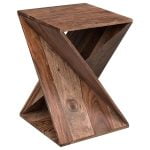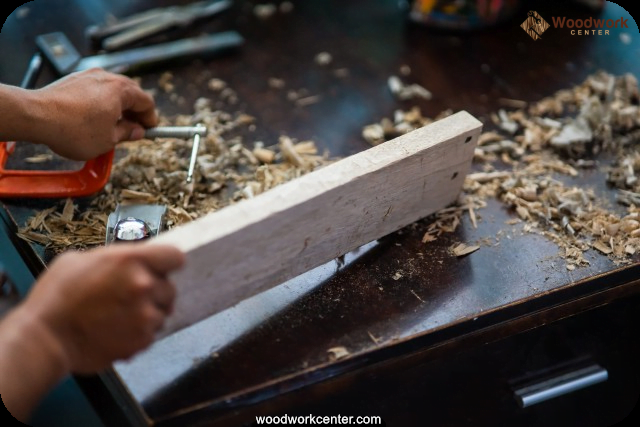Are you looking to embark on a new hobby and set up a beginner’s woodworking shop? Learning how to set up a beginners woodworking shop is the first step towards creating beautiful wood projects. Woodworking can be a rewarding and fulfilling hobby, allowing you to unleash your creativity and practical skills.
Understanding the basics of woodworking is essential before diving into setting up your own shop. It involves learning about different types of wood, tools, safety precautions, and techniques. With the right knowledge and preparation, you can create stunning pieces of furniture, decor, and more.
In this guide, we will walk you through the process of setting up a beginner’s woodworking shop. From selecting the right tools and workspace to organizing supplies and materials, we will cover everything you need to know to get started on your woodworking journey. Get ready to embrace your new hobby and enjoy the art of woodworking.
Selecting the Right Tools for a Beginner’s Woodworking Shop
Selecting the right tools is a crucial step in setting up a beginner’s woodworking shop. As a novice in the craft, it’s essential to have fundamental tools that will enable you to complete basic projects and develop your skills.
Some of the must-have tools for a beginner’s woodworking shop include a hammer, tape measure, utility knife, sawhorse, chisels, hand saws, drill and driver set, and a combination square. Investing in quality tools from the start will not only make your work easier but also ensure better results.
One important consideration when selecting tools for your woodworking shop is to prioritize versatility. Look for tools that can serve multiple functions and be used across various projects. For example, a combination square can be used for measuring, marking straight lines, and checking for squareness. This versatility will save you money and space in your workshop by eliminating the need for multiple specialized tools.
| Hand Tools | Power Tools |
|---|---|
| Hammer | Jigsaw |
| Tape Measure | Circular Saw |
| Chisels | Cordless Drill |
Choosing the Ideal Workspace for Your Woodworking Projects
When setting up a beginner’s woodworking shop, choosing the ideal workspace is crucial for your success. Your workspace should be a place where you feel comfortable, inspired, and able to work efficiently. Here are some key factors to consider when selecting the perfect location for your woodworking projects.
Location and Size
Consider the available space in your home or garage when choosing where to set up your woodworking shop. You’ll need enough room to comfortably move around and work on your projects without feeling cramped. Ensure that there is adequate lighting and ventilation in the space you choose as well.
Accessibility
It’s important to have easy access to your tools, materials, and workbench in your woodworking shop. Consider how you will transport large pieces of wood or equipment into the workspace without any obstacles in the way. Having a clear path from your storage area to your work area can help streamline your workflow.
Noise and Dust Considerations
Woodworking can produce a lot of noise and dust, so it’s essential to consider these factors when selecting a workspace. If possible, choose a location with good insulation to dampen noise levels and protect yourself from potential hearing damage. Additionally, consider investing in proper dust collection systems or wearing protective gear like goggles and masks to minimize exposure to wood particles.
By taking into account factors like location, size, accessibility, noise levels, and dust considerations when choosing the ideal workspace for your woodworking projects, you can create a functional and safe environment where you can hone your skills and unleash your creativity. Remember that setting up a beginner’s woodworking shop is all about creating a space that inspires you to learn and grow as a woodworker.
Essential Safety Precautions for Setting Up a Woodworking Shop
When setting up a beginner’s woodworking shop, one of the most important aspects to consider is safety. Woodworking involves the use of sharp tools and power equipment that can be potentially dangerous if not handled properly. To ensure a safe working environment, there are several essential safety precautions that need to be implemented in your woodworking shop.
First and foremost, always make sure to wear the appropriate safety gear when working in your woodworking shop. This includes safety goggles to protect your eyes from flying debris, ear protection to safeguard against loud noises from power tools, a dust mask to prevent inhalation of sawdust and other particles, and sturdy work gloves to protect your hands while handling materials and tools.
Another crucial safety precaution is to keep your workspace clean and organized at all times. Cluttered work areas increase the risk of accidents and injuries by creating trip hazards or obstacles that can interfere with safe woodworking practices. Make sure to have designated storage areas for tools, materials, and supplies, and always clean up after each project to maintain a safe working environment.
Additionally, it is important to familiarize yourself with the specific safety guidelines for each tool and piece of equipment in your woodworking shop. Proper usage and maintenance are key elements in preventing accidents. Take the time to read the user manuals for all your tools, and follow safety instructions diligently. Remember, it is better to take extra precautions than risk injury while pursuing your passion for woodworking.
Organizing Your Woodworking Supplies and Materials
When setting up a beginner’s woodworking shop, one of the most important steps is organizing your supplies and materials. A well-organized workspace not only helps you work more efficiently but also ensures safety in your shop. Here are some tips on how to set up your woodworking shop with a focus on organizing your supplies:
- Start by categorizing your woodworking supplies such as tools, hardware, lumber, and finishing materials. Having separate storage areas or containers for each category will make it easier for you to find what you need when working on a project.
- Invest in storage solutions such as tool cabinets, shelves, and bins to keep your supplies neatly organized and easily accessible. Pegboards are also great for hanging frequently used tools within arm’s reach.
- Labeling is key to maintaining an organized woodworking shop. Use labels or markers to clearly identify the contents of drawers, cabinets, and containers. This will save you time searching for specific items during a project.
In addition to organizing your supplies, it’s important to establish a system for managing inventory and replenishing materials when needed. Keep track of your stock levels for items like sandpaper, screws, and glue so that you never run out in the middle of a project. By staying organized and maintaining an efficient workflow in your woodworking shop, you can spend more time focusing on honing your skills and creating beautiful projects.
- Ensure that all sharp tools are stored safely and out of reach of children or pets.
- Regularly inspect power cords and plugs for any signs of wear or damage.
- Have a first aid kit readily available in case of minor injuries while working on projects.
Setting Up a Workbench for Woodworking Projects
Setting up a workbench is one of the most crucial steps in creating a functional and efficient woodworking shop. A well-designed workbench can make all the difference in the quality of your projects and your overall experience in the shop. Here are some tips on how to set up a workbench for woodworking projects as a beginner:
- Choose a sturdy and level workbench: The first step is to select a workbench that is strong enough to handle the weight and pressure of your woodworking projects. Make sure it is level to avoid any wobbling or instability while working.
- Consider the height of the workbench: The ideal height for a workbench is usually around hip level, allowing you to work comfortably without straining your back. If needed, you can adjust the height by adding or removing legs.
- Organize your tools and supplies: Keep your most frequently used tools within easy reach by installing pegboards, shelves, or tool holders on or near the workbench. This will help you stay organized and save time during your projects.
In addition to these tips, it’s important to ensure that your workbench has sufficient lighting and ventilation for a safe and comfortable working environment. Remember that your workbench will be the heart of your woodworking shop, so investing time and effort into setting it up properly will pay off in the long run.
- Install good lighting above your work area: Proper lighting is essential for precision woodworking tasks, so consider adding overhead lights or task lighting to brighten up your workspace.
- Provide adequate ventilation: Woodworking produces sawdust and fumes that can be harmful if inhaled regularly. Make sure your workshop has good airflow through windows, fans, or ventilation systems to keep the air clean.
- Add storage solutions: Utilize drawers, cabinets, or bins under or around the workbench to store tools, hardware, and materials. Having an organized storage system will help you keep track of everything you need for each project.
Learning the Fundamental Woodworking Techniques for Beginners
Woodworking is a fascinating hobby that allows individuals to express their creativity and craftsmanship through working with wood. As a beginner setting up your woodworking shop, it is essential to learn the fundamental techniques that will help you achieve successful projects. Understanding these basic skills will not only improve the quality of your work but also enhance your overall woodworking experience.
Understanding Wood Grain and Types of Wood
One of the first fundamental woodworking techniques for beginners is to understand the characteristics of different types of wood and how they react to tools and finishes. It’s crucial to familiarize yourself with wood grain patterns, hardness, and stability before starting any project. Knowing how to properly choose the right type of wood for each project can make a significant difference in the final outcome.
Measuring and Cutting Wood Accurately
Accurate measuring and cutting are essential skills in woodworking. Learning how to use measuring tools such as tape measures, rulers, squares, and marking gauges correctly will help you achieve precise cuts every time. Whether you are making straight cuts with a saw or intricate designs with a scroll saw, mastering the art of measuring and cutting wood accurately is crucial for successful projects.
Joinery Techniques for Beginners
Joinery refers to the methods used to connect two pieces of wood together. As a beginner woodworker, it is important to familiarize yourself with basic joinery techniques such as butt joints, miter joints, dado joints, and pocket hole joinery. These fundamental techniques will allow you to construct sturdy and durable furniture pieces while enhancing your woodworking skills. Practice these joinery techniques on scrap pieces of wood before incorporating them into your actual projects for better precision.
By mastering these fundamental woodworking techniques as a beginner, you will be well on your way to creating beautiful and functional projects in your new woodworking shop. Remember that practice makes perfect, so don’t be afraid to experiment and hone your skills through trial and error. Enjoy the process of learning and improving as you embark on this exciting journey into the world of woodworking.
Planning Your First Woodworking Project in Your New Shop
Once you have set up your beginner’s woodworking shop with the right tools, workspace, safety precautions, and organized supplies, it is time to plan your first woodworking project. Planning your first project is an exciting step in your woodworking journey as it allows you to put into practice the skills and techniques you’ve learned so far.
When planning your first woodworking project, consider starting with a simple and manageable project that aligns with your skill level. It could be a small shelf, a wooden box, or a basic furniture piece like a side table or bench. Choose a project that will allow you to practice fundamental woodworking techniques such as measuring, cutting, drilling, sanding, and assembling.
Before diving into your first woodworking project, take the time to create a detailed plan or blueprint of the final product. This plan should include measurements, materials needed, steps for construction, and any specific details or features you want to incorporate.
Having a clear plan in place will help guide you through the project smoothly and ensure that you achieve the desired result. As a beginner woodworker, it is important to approach each project with patience and attention to detail to build your skills and confidence in the craft.
As you embark on planning and executing your first woodworking project in your new shop, don’t be afraid to seek guidance from more experienced woodworkers through online resources, workshops, or classes. Learning from others can provide valuable insights and tips that will enhance your skills and understanding of woodworking techniques. Remember that every project is an opportunity to learn and grow as a woodworker while creating something beautiful and functional with your own hands.
Troubleshooting Common Issues in a Beginner’s Woodworking Shop
Setting up a beginner’s woodworking shop can be an exciting and fulfilling endeavor, but it is not without its challenges. As you start working on your woodworking projects, you may encounter some common issues that can hinder your progress. By being prepared and knowing how to troubleshoot these problems, you can ensure a smooth and productive woodworking experience.
One common issue that beginners often face in their woodworking shops is poor tool maintenance. Tools that are not properly cleaned, sharpened, or stored can lead to frustrating results and even safety hazards. To avoid this problem, it is essential to establish a regular maintenance routine for your tools.
Make sure to clean them after each use, sharpen blades when needed, and store them in a dry and organized manner. By taking care of your tools, you can improve the quality of your work and prolong the lifespan of your equipment.
Another issue that beginners may encounter in their woodworking shops is inadequate lighting. Proper lighting is crucial for precision work and preventing accidents. If you find yourself struggling with poor lighting in your workshop, consider investing in additional overhead lights, task lights, or clamp-on lights to illuminate your work area effectively.
Additionally, using reflective surfaces or light-colored walls can help bounce light around the space. With adequate lighting, you’ll be able to work more efficiently and accurately on your woodworking projects.
Additionally, beginners may face challenges related to dust control in their woodworking shops. Woodworking creates a significant amount of dust that can affect air quality and cover surfaces with debris. To address this issue, consider investing in a high-quality dust collection system or shop vacuum to capture dust at the source.
Regularly cleaning surfaces and floors with a damp cloth or mop can also help minimize dust buildup in your workshop. By implementing proper dust control measures, you can create a cleaner and healthier environment for all your woodworking activities.
Conclusion
In conclusion, setting up a beginner’s woodworking shop is an exciting journey that opens the doors to a world of creativity and craftsmanship. By understanding the basics of woodworking, selecting the right tools, choosing the ideal workspace, and prioritizing safety precautions, you can create a space where your woodworking skills can flourish.
Learning how to set up a beginner’s woodworking shop is not just about acquiring tools and materials; it’s about creating a sanctuary where you can immerse yourself in the art of woodworking. By organizing your supplies efficiently, setting up a functional workbench, and familiarizing yourself with fundamental woodworking techniques, you are taking essential steps towards honing your craft and embarking on fulfilling projects.
Remember, as you plan your first woodworking project in your new shop and encounter common issues along the way, persevere and embrace challenges as opportunities to grow. The key to success in woodworking is patience, practice, and a passion for creating beautiful pieces from wood. So go ahead, unleash your creativity, enjoy the process of crafting something with your hands, and savor every moment of embracing your new hobby in the art of woodworking.
Frequently Asked Questions
What Do You Need to Start a Wood Shop?
Starting a wood shop requires several key items. First and foremost, you’ll need essential woodworking tools such as saws, drills, sanders, and routers. Additionally, a sturdy workbench, storage for materials and supplies, and proper safety equipment are necessary. Don’t forget about dust collection systems to keep your workspace clean.
Are Woodworking Shops Profitable?
Woodworking shops can be profitable if managed properly. Success in this field often depends on factors such as the quality of your work, pricing strategy, marketing efforts, and customer base. By offering unique products or services, delivering exceptional craftsmanship, and building a loyal clientele, a woodworking shop has the potential to be profitable.
What Is the Minimum Size for a Workshop?
The minimum size for a workshop can vary depending on individual needs and the type of woodworking projects being undertaken. Generally, a small workshop can range from 80 to 100 square feet for basic hand tool work or small projects.
However, for larger power tools or more complex projects, a workshop of at least 200 to 400 square feet is recommended to allow for ample space to move around and work efficiently.

Hi everyone! I’m a woodworker and blogger, and this is my woodworking blog. In my blog, I share tips and tricks for woodworkers of all skill levels, as well as project ideas that you can try yourself.





